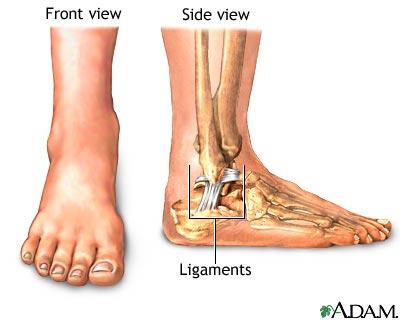Ankle Injuries
And how to care for them.
One night when called in to see a patient and trying to quietly exit our bedroom, I painfully twisted my ankle. In the stream of invective that followed, I discovered that I resent professional basketball players. Overpaid to play a game with no benefit to humanity, they were probably sound asleep while I stumbled around in the dark, en route to helping someone in need. At the same time, it occurred to me that these felonious mutants have taught us a great deal about treating ankle injuries.
Ankles are probably the most commonly injured joint in sports and other fun activities. They are very mobile structures and frequently have all our weight bearing on them. Any change in direction, jumping, or irregularity in the footing puts them at risk for injury.
The structure of the ankle is a careful balance between the strength and rigidity provided by the hard bones, and the flexibility and mobility provided by the soft tissues, called ligaments (see illustration). The rigidity comes from the lower ends of the leg bones, which hold the top of the large foot bone (the talus) in a firm embrace. Broken bones in the ankle, or the foot near the ankle, have a high risk for producing a poor result and should be managed by a physician.
The ligaments are leathery bands of tissue that bridge between the lower leg bones and the foot bones, and also between the two leg bones (see illustration). These ligaments allow the ankle joint to freely move, up to a point and then no further.
A sprain, the most common ankle injury, occurs when a ligament is stretched farther than it’s designed to. The damage produces pain and bleeding. The amount of the ligament injured varies, from a small portion causing a minor injury to a complete tear through the ligament. The amount of pain, bruising, and swelling generally varies with the extent of injury, except that complete tears may be surprisingly painless. Complete tears are at high risk for a poor outcome.
Most ankle sprains that we see in the office are intermediate in severity. With proper care, these heal well, and with NBA-style treatment, relatively quickly.
How do you know when you should seek help and when you can manage on your own? In my opinion, if you can pass the Ottawa Ankle Rules (see below), have mild swelling confined to the outer ankle and little or no bruising, you can probably treat your ankle yourself. Follow the initial first aid treatment. If you have more than minimal symptoms, a physician’s evaluation is warranted.
How do you tell if your ankle is sprained or broken? Often patients think their ankle must be broken because they heard a “pop”—but in my experience, a pop is much more likely to come from a sprain than a break. Others incorrectly think because they can move it, then it’s not broken. Physicians in Ottawa, Canada developed guidelines that help us determine who clearly does NOT have a serious fracture. Everyone who can’t pass the rule needs an X-ray to know.
Initial NBA-style treatment (see below) for all ankle injuries is very useful in speeding recovery. Immediately elevate your leg and apply ice to the injured spot. If you know how to monitor the circulation downstream, wrap the ankle snuggly with an elastic bandage to apply compression. Be careful; a wrap that is too tight can cut off circulation and cause more damage.
If you’re miles from anywhere, be creative and make the best choices you can. Soak your ankle in that frigid stream. Wrap your ankle with the Ace wrap you always carry. Or leave your boot on and lace it snugly while you hike out. If you think it’s broken or you can’t walk on it, you’ll need to call for help.
My strong preference in treating ankle sprains is to use an air splint and prescribe early motion. Air splints are clever devices that restrict painful sideways motion but allow free forward-back movement. After 48 hours of ice and elevation, the air splint allows you to start walking, working, and swimming, progressing to biking on level ground or jogging, sometimes in a few days. After 1-2 weeks, you wear the splint less and less, until it is no longer needed.
Complications of ankle sprains do occur. Occasionally, the ligament that runs between the two leg bones is injured, what the sports pages call a “high ankle sprain.” This is a very troublesome injury that takes months to heal. Also, occasionally, an ankle sprain can produce loss of position sense in the ankle, which leaves the victim with an odd, unstable sense or repeated minor sprains. Both of these complications can benefit from the help of a trainer or physical therapist.
The longest-lasting poor result from ankle sprains is a loose or sloppy ankle. The ligament, generally from repeated injury, is stretched and can no longer provide a solid stop to motion at the right point. Sometimes exercise can help with this problem, though oftentimes athletes with loose ligaments need to wear a supportive brace when they play. Rarely, surgery is needed.
The most important take home message is Be Like Mike (Jordan) and immediately elevate, ice, and wrap your ankle when it’s injured. And then get competent help.
Dean Center, M.D., was a physician at Family Doctors' Urgent Care in Bozeman.
Ottawa Ankle Rules
If you don’t know where to feel, don’t use the rules!
-Can walk 20 feet right after injury
-No posterior tenderness in lower tibia (inside leg bone)
-No posterior tenderness in lower fibula (outside leg bone)
-No tenderness at base of the 5th metatarsal (outside of foot)
-No tenderness over navicular (inside of foot)
NBA-Style Treatment for Ankle Sprains
IMMEDIATELY, get shoe off and:
-Elevate — sit with foot higher than hip.
-Ice — apply gel pack or bag of snow/crushed ice, constantly for the first 45 minutes, then 15 minutes every 2-3 hours.
-Compress — if it can be safely monitored, wrap snugly with an elastic bandage OR put on ankle air splint and wear continuously.
After 48 hours:
-Soak ankle in hot water, moving it around, then elevate for 15 minutes, 2-4 times daily. (Recent evidence supports use of ice water in place of hot water.)
-Wear ankle air splint, if not already.
-Start early motion, as walking or swimming.
-As able, progress to stationary biking, then jogging.
-After one week or so, as able, go without splint when relaxing at home.
-After 2-3 weeks, go without splint for all but most vigorous, ankle stressing activities.
-When swelling and bruising is all gone, and you are able to do normal activities without pain, stop soaks and use of splint.











